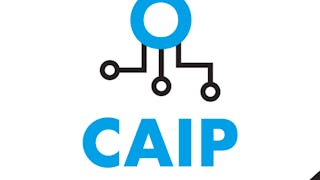In most cases, the ultimate goal of a machine learning project is to produce a model. Models make decisions, predictions—anything that can help the business understand itself, its customers, and its environment better than a human could. Models are constructed using algorithms, and in the world of machine learning, there are many different algorithms to choose from. You need to know how to select the best algorithm for a given job, and how to use that algorithm to produce a working model that provides value to the business.

Enjoy unlimited growth with a year of Coursera Plus for $199 (regularly $399). Save now.

Build Regression, Classification, and Clustering Models
This course is part of CertNexus Certified Artificial Intelligence Practitioner Professional Certificate

Instructor: Anastas Stoyanovsky
3,441 already enrolled
Included with
(18 reviews)
Recommended experience
What you'll learn
Train and evaluate linear regression models.
Train binary and multi-class classification models.
Evaluate and tune classification models to improve their performance.
Train and evaluate clustering models to find useful patterns in unsupervised data.
Skills you'll gain
Details to know

Add to your LinkedIn profile
See how employees at top companies are mastering in-demand skills

Build your Machine Learning expertise
- Learn new concepts from industry experts
- Gain a foundational understanding of a subject or tool
- Develop job-relevant skills with hands-on projects
- Earn a shareable career certificate from CertNexus

There are 6 modules in this course
In the preceding course, you went through the overall machine learning workflow from start to finish. Now it's time to start digging into the algorithms that make up machine learning. This will help you select the most appropriate algorithm(s) for your own purposes, as well as how best to apply them to solve a problem. A good place to start is with simple linear regression.
What's included
13 videos3 readings1 assignment1 discussion prompt1 ungraded lab
The simple model you created earlier works well in many cases, but that doesn't mean it's the optimal approach. Linear regression can be enhanced by the process of regularization, which will often improve the skill of your machine learning model. In addition, an iterative approach to regression can take over where the closed-form solution falls short. In this module, you'll apply both techniques.
What's included
8 videos3 readings1 assignment1 discussion prompt2 ungraded labs
Besides linear regression, the other major type of supervised machine learning outcome is classification. To begin with, you'll train some binary classification models using a few different algorithms. Then, you'll train a model to handle cases in which there are multiple ways to classify a data example. Each algorithm may be ideal for solving a certain type of classification problem, so you need to be aware of how they differ.
What's included
9 videos3 readings1 assignment1 discussion prompt2 ungraded labs
It's not enough to just train a model you think is best, and then call it a day. Unless you're using a very simple dataset or you get lucky, the default parameters aren't going to give you the best possible model for solving the problem. So, in this module, you'll evaluate your classification models to see how they're performing, then you'll attempt to improve their skill.
What's included
16 videos3 readings1 assignment1 discussion prompt2 ungraded labs
You've built models to tackle linear regression problems and classification problems. One of the other major machine learning tasks that you might want to engage in is clustering, a form of unsupervised learning. In this module, you'll see how a machine learning model can help you identify useful patterns even when the data you have to work with isn't labeled.
What's included
9 videos4 readings1 assignment1 discussion prompt2 ungraded labs
You'll work on a project in which you'll apply your knowledge of the material in this course to practical scenarios.
What's included
1 peer review1 ungraded lab
Earn a career certificate
Add this credential to your LinkedIn profile, resume, or CV. Share it on social media and in your performance review.
Instructor

Offered by
Explore more from Machine Learning
 Status: Free Trial
Status: Free Trial Status: Free Trial
Status: Free Trial Status: Preview
Status: Preview Status: Preview
Status: Preview
Why people choose Coursera for their career





Open new doors with Coursera Plus
Unlimited access to 10,000+ world-class courses, hands-on projects, and job-ready certificate programs - all included in your subscription
Advance your career with an online degree
Earn a degree from world-class universities - 100% online
Join over 3,400 global companies that choose Coursera for Business
Upskill your employees to excel in the digital economy
Frequently asked questions
To access the course materials, assignments and to earn a Certificate, you will need to purchase the Certificate experience when you enroll in a course. You can try a Free Trial instead, or apply for Financial Aid. The course may offer 'Full Course, No Certificate' instead. This option lets you see all course materials, submit required assessments, and get a final grade. This also means that you will not be able to purchase a Certificate experience.
When you enroll in the course, you get access to all of the courses in the Certificate, and you earn a certificate when you complete the work. Your electronic Certificate will be added to your Accomplishments page - from there, you can print your Certificate or add it to your LinkedIn profile.
More questions
Financial aid available,
¹ Some assignments in this course are AI-graded. For these assignments, your data will be used in accordance with Coursera's Privacy Notice.

